One of the things I love best about our region of France is that the preparations for Christmas only begin in December. Suddenly, on the last days of November, ‘cherry pickers’ park up in highly inconvenient parts of the city in the middle of rush hour and the council start to put up christmas lights, causing the circulation to grind to a standstill. Somehow the excitement caused is more intense than the long drawn out decorations of the UK which seem to appear as soon as the British shops have cleared the last of Halloween.
Today I was booked in for ‘La Bûche de Noel’ at the Atelier de Patisserie and savoured the new decorations as I made my way there.
 Under the shadow of the cathedral the Marché de Noel was just opening up,
Under the shadow of the cathedral the Marché de Noel was just opening up,
while the pretty side street that led to the atelier was charming with its simple lights and foliage.
I was momentarily dazzled by the sweet stall
 and spent a few moments watching the young ‘Dragons Ice Hockey team on the christmas rink outside the Hôtel de Ville.
and spent a few moments watching the young ‘Dragons Ice Hockey team on the christmas rink outside the Hôtel de Ville.
But Arnaud’s atelier was calling, and within minutes I was equipped with Tablier (apron) and ready for the class to begin.
Today we were making the Bûche de Noel (traditional Christmas log) with a roulade of Biscuit Viennoise and Crème de Beurre.
As ever, Arnaud was a mine of information. What he doesn’t know about eggs isn’t worth knowing, but what is, is that egg yolks can be stored in a freezer for a month, and that freshly laid eggs do not whip well. Eggs should always be left for a few days before using for patisserie. Aparently, although he didn’t know the science behind it, frozen egg whites or a egg white and 10% water mix whip more quickly than standard eggs.
All egged out, we turned to start making the Biscuit viennoise.
We weighed out our ‘Tant pour Tant’ (such for such, the french expression for replacing one ingredient for an equally acceptable alternative) with an equal mixture of ground almonds and icing sugar. Any powdered dried fruit would work, ground hazelnut for example. We added the egg yolks and full eggs and whipped until creamy and light. Arnaud had plans for strengthening our arm muscles, and got us to work with a hand whisk!

Then we whipped the egg whites into peaks and added the sugar to form a thick meringue.
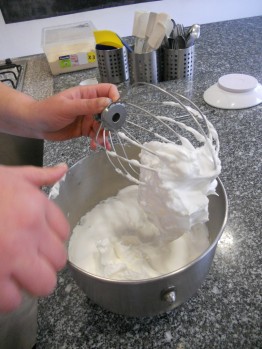 With a soft folding action we incorporated the meringue into the TPT mixture.
With a soft folding action we incorporated the meringue into the TPT mixture.
 Once thoroughly incorporated we poured onto a greaseproof paper on a long baking tray.
Once thoroughly incorporated we poured onto a greaseproof paper on a long baking tray.

And with a spatula laid it smooth taking care to use as few strokes as possible.
Once complete we placed it in the oven and prepared to make the filling.
Arnaud educated us on the various types of meringue; French, Suisse and Italien. The French form of meringue already having been used to create the volume for the Biscuit Viennoise.
Meringue Italienne is an uncookable meringue, which does not dry and is always used for making patisserie creams. This is the type of meringue we now use for making the Crème à Beurre.
Arnaud amuses us by admitting that he likes his steak ‘bien cuite'(I have known customers thrown out of restaurants for asking for that) as opposed to his wife who like’s hers bleu. Can we believe he is really a chef? To achieve this with perfect timing he shows us his thermometer.
We place the water and sugar mixture on the hob and bring to 115°, at the same time whipping the egg whites into peaks.
Arnaud shows us what happens to the sugar if the temparture rises to 120°. A brittle, unworkable sugar that would break our mixer!
We carefully measure the sugar solution temperature and at exactly 115° pour it carefully down the side of the whipped egg bowl.
We leave the mixer to beat to a smooth thick meringue, before adding the butter to make the crème à beurre.
There are two ways to add the butter, one is to add the entire cold quantity of butter to the warm meringue mixture where the heat softens and helps it incorporate to a smooth cream.
The second method is to make the butter into a beurre pommade. Keeping the butter at a constant temperature of 37° we continually beat the butter until the consistancy of a ‘face cream’.
The end result is a thicker crème for the solid butter, and a lighter crème for the pommade.
We add the flavour, pistachio to one and chocolate to the other, ready to spread over our cooked golden Biscuit Viennoise.
Our biscuit is golden and we divide in two to form two ‘Bûche’, one of which we spread thinly with pistachio crème, the other with chocolate.
Before rolling the Biscuit Viennoise into a roulade, moistening where necessary with a sugar syrup.
We spread the outside of the log with more crème chocolate and fork to give a ‘log’ texture.
The final stage of the atelier is to experiment with ‘Meringue Suisse’.
The beauty of meringue suisse is that it is excellent for forming little decorations as it looses its shape much more slowly.
We measure a two to one part mix of sugar and egg white. We whisk the mixture whilst heating it at a constant temperature of 50° until it begins to thicken, and then put into the Kitchen Aid to continue whisking until it forms a stiff meringue.
We place several differently sized ‘douilles’ (nozzles) into several icing bags, twist the bag to form a ‘bouchon’ or cork in the nozzle, and fill the bags with meringue. Once ready we pull out the bouchon and push the meringue firmly into the nozzle.
We take a baking tray with a greaseproof sheet and begin to form various shapes, mushrooms and snails and old boots with which we will decorate our ‘bûche’.
Having dried in the oven, the meringue decorations are ready to use.
A final photo – well no, that’s for you to create!
As for our ‘Bûche de Noel’ – its already been eaten!
A little early I know, but it was my birthday today! I think we can be forgiven! (Well we just couldn’t stop ourselves!)
As for you, the ‘Bûche de Noel’ freezes perfectly, so you have no excuses!
For the recipe: Bûche de Noel
To read further blogs taking part in the Expat Blog Hop, click on the links.
 Steve Bichard.com
Steve Bichard.com
![]() Books are Cool
Books are Cool
 Life on La Lune
Life on La Lune
 RunQuiltKnitWrite
RunQuiltKnitWrite
 Victoria Corby
Victoria Corby
 Bordeaux Bumpkin
Bordeaux Bumpkin
 Scribbler in Seville
Scribbler in Seville
 Blog in France
Blog in France
Leaving Cairo
![]() Chronicles of M
Chronicles of M
 Mummigrants
Mummigrants
Didi Books English


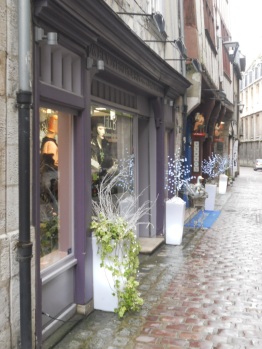

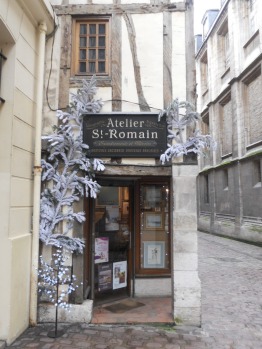





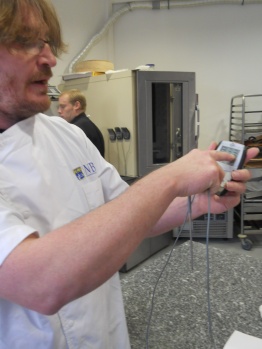

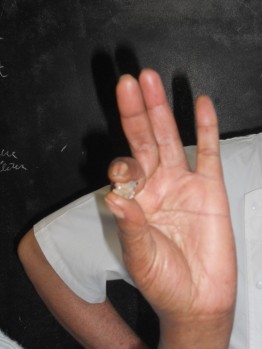



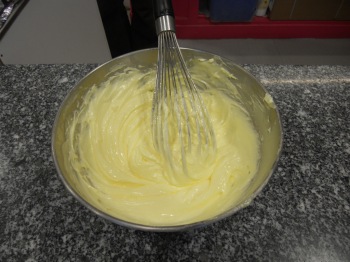



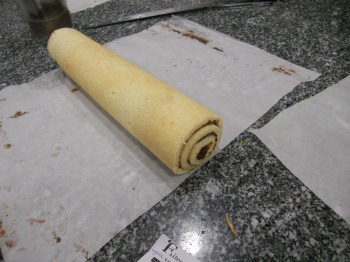
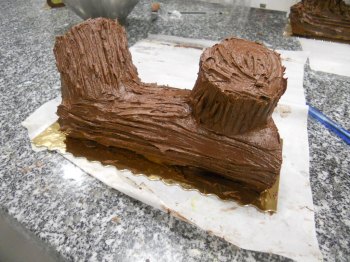






 Vive Trianon
Vive Trianon Melanged Magic
Melanged Magic Painting in Tuscany
Painting in Tuscany Piglet in Portugal
Piglet in Portugal Box53b Naomi Hattaway
Box53b Naomi Hattaway Suzanna Williams
Suzanna Williams Steven C Sobotka
Steven C Sobotka Beyond Manana in Spain
Beyond Manana in Spain Jeno Marz
Jeno Marz Aussie in france
Aussie in france
Hello, hopping over from French Village Diaries. I am so jealous and I so need to find myself an atelier to give a buche de Noel another go, mine was a non-roll disaster, but your great pics have helped me to see where I went wrong 🙂
LikeLike
Hi Jacqui, The secret is to be really gentle with the ‘biscuit’ mix and keep the air in it, When rolling it up use the greaseproof paper(once you have detached the cooked biscuit from it) to help roll it up. Using the paper helps put even pressure on the biscuit as you roll it.
The syrop helps to keep it moist. I’m puttiing the recipe online now.
LikeLike
Happy Birthday! Bet the cake was good….
LikeLike
Lasted about 5 minutes!
LikeLike
Looks like a lot of work, but seemed to create a great cake! Congratulations!
LikeLike
Looks complicated, but yummy! I think doing this project with a professional chef is the only way to go.
LikeLike
II guess the crème à beurre is more complicated than a standard butter cream but it keeps longer. For a simpler recipe make the biscuit viennoise, and simplify the filling with your own favourite. The beauty of this is that it’s a lovely texture and totally ok for coeliacs, who generally don’t get to eat cake. As with anything it’s easier once you’ve done it once, and its fun to have the authentic french recipe.
LikeLike
Hopping over from Word by Word and I am very impressed with the amazing process to make La Bûche de Noel, looks very complicated and thank goodness it is as simple as popping into the patisserie!
LikeLike
My dad makes a Buche de Noel every year for Christmas Eve since we usually host. It is very rich and filling but I love it! He also makes an accompanying “creme anglaise” (not sure why it is called that) to pour over your slice of the buche which is amazing. We usually have two buches at Christmas–the one my father makes and one we order from this fancy French restaurant in our area. I might try to help him make it this year! 😀
LikeLike
Sounds amazing Amelie. I bet your dad’s is the best!!
LikeLike
Wow all this lovely cooking is making me hungry, I put on a stone just reading all these blog hops.
LikeLike
Ooh la la La sacré bûche! They all looked really good even though I don’t really like it. I think it’s all in the ingredients and how you handle the mixing. There’s nothing better than a homemade one.
LikeLike
Thanks for liking my post. You should sign up for the giveaway. You can win the book of your choice. Just writie the name of the title and why you want to read it.
LikeLike
I’ve just hopped over to you having mulled over my choice for a while!
LikeLike
Saw it. Good luck!
LikeLike
That looks muito complicado!
LikeLike
but thankfully muito delishiado – otherwise i’d be crying into my apron by now!
LikeLike
🙂
LikeLike